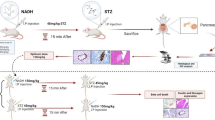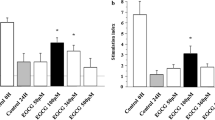Abstract
Hydroxychloroquine (HCQ) is supposed to have favorable effects in diabetes mellitus (DM). However no previous experimental studies had investigated its effect on the structure of the endocrine pancreas, islets of Langerhans (IOL), in DM. In addition, the mechanism by which HCQ acts in DM is not well understood. In this study, we hypothesized that the possible favorable effects of HCQ in DM at the structural as well as at metabolic levels could be accomplished, in part, by its anti-inflammatory action. A total of 45 rats were divided equally into; control, DM and HCQ + DM groups (received citrate buffer, 27.5 mg/kg single ip STZ and STZ + HCQ 200 mg/kg/w respectively). After 4 weeks, samples from pancreas were histologically studied for the resulting changes. The HCQ + DM group showed preservation of IOL structure, a significant increase (p < 0.05) in the β-cell area, %, mass, IOL proliferation and neogenesis as well as correction of the significantly increased (p < 0.05) α-cell area, %, disturbed glucose homeostasis and lipid profile compared with the DM group. The significantly elevated inflammatory cytokines in the latter were lowered in the HCQ + DM group. Therefore, HCQ showed definite favorable effects on the histological as well as the metabolic profiles in DM which may be partly attributed to its anti-inflammatory action. This notable improvement of DM by HCQ deserves further studies to distinctly approve HCQ as a promising oral hypoglycemic agent.








Similar content being viewed by others
References
Akarte AS, Srinivasan BP, Gandhi S (2012) A novel long acting DPP-IV inhibitor PKF-275-055 stimulates beta-cell proliferation resulting in improved glucose homeostasis in diabetic rats. Biochem Pharmacol 83:241–252
Alexandraki K, Piperi C, Kalofoutis C et al (2006) Inflammatory process in type 2 diabetes: the role of cytokines. Ann N Y Acad Sci 1084:89–117
Araiza-Casillas R, Diaz-Molina R, Gonzalez-Ortiz M et al (2013) Effects of hydroxychloroquine on insulin sensitivity and lipid profile in patients with rheumatoid arthritis. Rev Med Chile 141:1019–1025
Barbarroja N, Lopez-Pedrera C, Garrido-Sanchez L et al (2012) Progression from high insulin resistance to type 2 diabetes does not entail additional visceral adipose tissue inflammation. PLoS one 7:e48155
Bastard JP, Maachi M, Lagathu C et al (2006) Recent advances in the relationship between obesity, inflammation, and insulin resistance. Eur Cytokine Netw 17:4–12
Butler AE, Janson J, Soeller WC et al (2003) Increased beta-cell apoptosis prevents adaptive increase in beta-cell mass in mouse model of type 2 diabetes: evidence for role of islet amyloid formation rather than direct action of amyloid. Diabetes 52:2304–2314
Carter JD, Dula SB, Corbin KL et al (2009) A practical guide to rodent islet isolation and assessment. Biol Proced Online 11:3–31
Costedoat-Chalumeau N, Dunogue B, Morel N et al (2014) Hydroxychloroquine: a multifaceted treatment in lupus. Presse Med (Paris, France:1983) 43:e167–e180
Fresno M, Alvarez R, Cuesta N (2011) Toll-like receptors, inflammation, metabolism and obesity. Arch Physiol Biochem 117:151–164
Friedewald WT, Levy RI, Fredrickson DS (1972) Estimation of the concentration of low-density lipoprotein cholesterol in plasma, without use of the preparative ultracentrifuge. Clin Chem 18:499–502
Galic S, Oakhill JS, Steinberg GR (2010) Adipose tissue as an endocrine organ. Mol Cell Endocrinol 316:129–139
Garcia FA, Reboucas JF, Balbino TQ et al (2015) Pentoxifylline reduces the inflammatory process in diabetic rats: relationship with decreases of pro-inflammatory cytokines and inducible nitric oxide synthase. J Inflamm (London, England) 12:33
Gerstein HC, Thorpe KE, Taylor DW et al (2002) The effectiveness of hydroxychloroquine in patients with type 2 diabetes mellitus who are refractory to sulfonylureas—a randomized trial. Diabetes Res Clin Pract 55:209–219
Guardado-Mendoza R, Davalli AM, Chavez AO et al (2009) Pancreatic islet amyloidosis, beta-cell apoptosis, and alpha-cell proliferation are determinants of islet remodeling in type-2 diabetic baboons. Proc Natl Acad Sci USA 106:13992–13997
Guzman-Flores JM, Lopez-Briones S (2012) Cells of innate and adaptive immunity in type 2 diabetes and obesity. Gac Med Mex 148:381–389
Harford KA, Reynolds CM, McGillicuddy FC et al (2011) Fats, inflammation and insulin resistance: insights to the role of macrophage and T-cell accumulation in adipose tissue. Proc Nutr Soc 70:408–417
Hayden MR (2002) Pancreatic islet amyloid in type 2 diabetes mellitus: a clinical and historical review. Mo Med 99:495–498
Herder C, Carstensen M, Ouwens DM (2013) Anti-inflammatory cytokines and risk of type 2 diabetes. Diabetes Obes Metab 15(Suppl 3):39–50
Jones HB, Nugent D, Jenkins R (2010) Variation in characteristics of islets of Langerhans in insulin-resistant, diabetic and non-diabetic-rat strains. Int J Exp Pathol 91:288–301
Katsuda Y, Ohta T, Miyajima K et al (2014) Diabetic complications in obese type 2 diabetic rat models. Exp Anim Jpn Assoc Lab Anim Sci 63:121–132
Lopes-Virella MF, Stone PG, Colwell JA (1977) Serum high density lipoprotein in diabetic patients. Diabetologia 13:285–291
Matveyenko AV, Butler PC (2006) Beta-cell deficit due to increased apoptosis in the human islet amyloid polypeptide transgenic (HIP) rat recapitulates the metabolic defects present in type 2 diabetes. Diabetes 55:2106–2114
Mercer E, Rekedal L, Garg R et al (2012) Hydroxychloroquine improves insulin sensitivity in obese non-diabetic individuals. Arthritis Res Ther 14:R135
Montanya E, Tellez N (2009) Pancreatic remodeling: beta-cell apoptosis, proliferation and neogenesis, and the measurement of beta-cell mass and of individual beta-cell size. Methods Mol Biol (Clifton, N.J.) 560:137–158
Navarro-Gonzalez JF, Mora-Fernandez C (2008) The role of inflammatory cytokines in diabetic nephropathy. J Am Soc Nephrol JASN 19:433–442
Nugent DA, Smith DM, Jones HB (2008) A review of islet of Langerhans degeneration in rodent models of type 2 diabetes. Toxicol Pathol 36:529–551
Odegaard JI, Chawla A (2012) Connecting type 1 and type 2 diabetes through innate immunity. Cold Spring Harbor Perspect Med 2:a007724
Olsen NJ, Schleich MA, Karp DR (2013) Multifaceted effects of hydroxychloroquine in human disease. Semin Arthritis Rheum 43:264–272
Pae EK, Ahuja B, Kim M et al (2013) Impaired glucose homeostasis after a transient intermittent hypoxic exposure in neonatal rats. Biochem Biophys Res Commun 441:637–642
Pareek A, Yeole PG, Tenpe CR et al (2009) Effect of atorvastatin and hydroxychloroquine combination on blood glucose in alloxan-induced diabetic rats. Indian J Pharmacol 41:125–128
Penn SK, Kao AH, Schott LL et al (2010) Hydroxychloroquine and glycemia in women with rheumatoid arthritis and systemic lupus erythematosus. J Rheumatol 37:1136–1142
Psyrogiannis A, Kyriazopoulou V, Symeonidis A et al (2003) Relative iron “overload” in offspring of patients with type 2 diabetes mellitus: a new component in the conundrum of insulin resistance syndrome? Hormones (Athens, Greece) 2:161–168
Quatraro A, Consoli G, Magno M et al (1990) Hydroxychloroquine in decompensated, treatment-refractory noninsulin-dependent diabetes mellitus. A new job for an old drug? Ann Intern Med 112:678–681
Rekedal LR, Massarotti E, Garg R et al (2010) Changes in glycosylated hemoglobin after initiation of hydroxychloroquine or methotrexate treatment in diabetes patients with rheumatic diseases. Arthritis Rheum 62:3569–3573
Richardson VR, Smith KA, Carter AM (2013) Adipose tissue inflammation: feeding the development of type 2 diabetes mellitus. Immunobiology 218:1497–1504
Solomon DH, Garg R, Lu B et al (2014) Effect of hydroxychloroquine on insulin sensitivity and lipid parameters in rheumatoid arthritis patients without diabetes mellitus: a randomized, blinded crossover trial. Arthritis Care Res 66:1246–1251
Spranger J, Kroke A, Mohlig M et al (2003) Inflammatory cytokines and the risk to develop type 2 diabetes: results of the prospective population-based European Prospective Investigation into Cancer and Nutrition (EPIC)-Potsdam Study. Diabetes 52:812–817
Ti Y, Xie GL, Wang ZH et al (2011) TRB3 gene silencing alleviates diabetic cardiomyopathy in a type 2 diabetic rat model. Diabetes 60:2963–2974
Tomita T (2010) Immunocytochemical localisation of caspase-3 in pancreatic islets from type 2 diabetic subjects. Pathology 42:432–437
Tomita T (2012) Islet amyloid polypeptide in pancreatic islets from type 2 diabetic subjects. Islets 4:223–232
Wang X, Bao W, Liu J et al (2013) Inflammatory markers and risk of type 2 diabetes: a systematic review and meta-analysis. Diabetes Care 36:166–175
Wasko MC, Hubert HB, Lingala VB et al (2007) Hydroxychloroquine and risk of diabetes in patients with rheumatoid arthritis. JAMA 298:187–193
Wasko MC, McClure CK, Kelsey SF et al (2015) Antidiabetogenic effects of hydroxychloroquine on insulin sensitivity and beta cell function: a randomised trial. Diabetologia 58:2336–2343
Wieser V, Moschen AR, Tilg H (2013) Inflammation, cytokines and insulin resistance: a clinical perspective. Archivum Immunologiae et therapiae Experimentalis 61:119–125
Zou CY, Gong Y, Liang J (2014) Metabolic signaling of insulin secretion by pancreatic beta-cell and its derangement in type 2 diabetes. Eur Rev Med Pharmacol Sci 18:2215–2227
Author information
Authors and Affiliations
Corresponding author
Ethics declarations
Conflict of interest
There is no conflict of interest.
Rights and permissions
About this article
Cite this article
Abdel-Hamid, A.A.M., El-Firgany, A.ED.L. Hydroxychloroquine hindering of diabetic isletopathy carries its signature on the inflammatory cytokines. J Mol Hist 47, 183–193 (2016). https://doi.org/10.1007/s10735-016-9664-5
Received:
Accepted:
Published:
Issue Date:
DOI: https://doi.org/10.1007/s10735-016-9664-5




